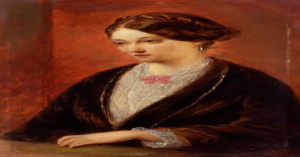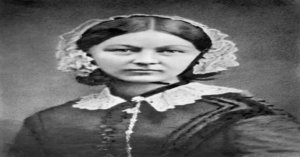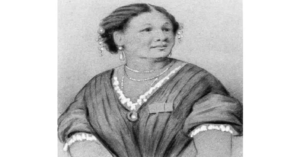The Lady with the Lamp – Florence Nightingale’s Life & Legacy
The Woman Behind the Lamp: Florence Nightingale’s Radical Humanity

“I stand at the altar of the murdered men, and, while I live, I fight their cause.”
— Florence Nightingale, 1857
The lamplight glows gold in every textbook illustration – a saintly figure floating through Crimean hospital wards, comforting dying soldiers. But the real Florence Nightingale smelled of carbolic soap and sweat, had ink-stained fingers, and once screamed at a War Office clerk: “Your bureaucratic murder killed more men than Russian bullets!” She chain-smoked cigars during 20-hour workdays, collapsed from chronic pain at 38, and kept a rescued owl in her pocket. This is the woman who invented modern nursing – not a porcelain angel, but a flesh-and-blood revolutionary.
The Caged Bird (1820-1844)
Florence, Italy: Born in a rented palazzo to wealthy British parents, she entered life drowning in privilege. Her nursery overlooked the Duomo, but young Florence preferred the hospital for abandoned infants downstairs. At six, she documented sick village dogs’ symptoms in a notebook: “Spot: shivers, won’t eat, licks mud.”
Victorian Cage:
- Mother Fanny: “Florence, stop measuring the soup portions for servants! It’s vulgar!”
- Sister Parthenope: “Come practice quadrilles! Lord Worthington will be at the ball!”
- Florence’s diary (age 17): “The corset is strangling me. Why must women be decorative coffins?”
The Calling: On February 7, 1837, walking in the Embley Park gardens, 16-year-old Florence heard God’s voice: “You are here to ease suffering.” When she confessed her nursing vocation, Fanny collapsed onto fainting couch: “Next you’ll want to empty chamber pots!”
Breaking the Chandeliers (1845-1854)

Germany, 1851: At Pastor Fliedner’s clinic, Florence finally touched real medicine:
- Delivered a breech baby in a Düsseldorf slum while rats scuttled over straw
- Washed syphilis sores on prostitutes discarded by society
- Learned triage during a typhus outbreak: “Save those who can be saved”
Return to London:
Fanny staged interventions: “Marry Richard Monckton Milnes! He’s rich!”
Florence refused the poet’s proposal, writing coldly: “I have no need of a husband when corpses need washing.”
Her sister burned her nursing textbooks in the fireplace.
Scutari: Hell’s Waiting Room (1854-1856)
November 4, 1854: Florence arrived at Scutari Barracks with 38 nurses. The scene:
graph LR
A[Overflowing Sewers] --> B[Cholera]
C[4 Men/1 Bed] --> D[Gangrene]
E[Unwashed Bandages] --> F[Typhus]
G[Surgeons Drinking] --> H[Amputations Without Anesthesia]
Soldiers called her “The Brute”:
- She confiscated liquor from nurses: “Drunk hands spread death!”
- Slapped a surgeon operating with manure-caked boots
- Ordered 200 scrubbing brushes: “If you won’t heal, scrub!”
Midnight, Ward 7:
A boy shivered, clutching a miniature of his mother. Florence sat on his lice-infested pallet:
“What’s her name, soldier?”
“Mary, ma’am.”
“Tell Mary about her brave son.”
She wrote his last words as he died clutching her skirt.
The Owl and the Lamp
Athena: Florence rescued the baby owl during Crimean nights. It perched on her lamp, hooting at rats. She fed it bacon scraps and let it nest in her cap.
The Real Lamp Ritual:
- 8 PM: Nurses massaged her spine so she could stand
- 9 PM – 4 AM: Walked 4 miles of wards, lamp weighing 7 lbs
- Not poetry: She checked pulses with dirty fingers because gloves weren’t sterile
- Dawn: Collapsed, coughing blood while Athena preened her hair
Florence Nightingale Secret Weapon: Statistics
While officers dismissed her as “that hysterical female,” Florence cataloged deaths:
| Cause | Pre-Nightingale | Post-Reforms |
|---|---|---|
| Battle Wounds | 8% | 7% |
| Preventable Disease | 42% | 2% |
“Gentlemen,” she told Parliament, “your neglect is the true weapon of mass destruction.”
The Bedridden General (1857-1880)
Collapse: Returned to England with brucellosis and PTSD. For 53 years, she directed global healthcare from a London sofa.
Revolution by Mail:
- To Lincoln (1862): “Separate gangrene cases! Maggots clean wounds!” (Civil War death rates dropped 38%)
- To India (1865): “Build latrines downstream!” (Famine deaths fell by 200,000/year)
- To Nurses: “Wash! Even if surgeons mock you!”
Pain Rituals:
- 3 AM: Wrapped spine in hot opium compresses
- 5 AM: Dictated letters while vomiting from pain
- 10 AM: Smoked a cigar, reviewing hospital blueprints
The Betrayal: When Parthenope published “sanitized” diaries, Florence raged: “You turned my blood into lavender water!”
Florence Nightingale : Shadows on the Legend
Her Blind Spots:
- Dismissed Indian healers as “superstitious natives”
- Oppitted women doctors: “Nursing is science; doctoring is masculine”
- Secretly funded a nurse’s abortion then erased her from records
The Cost:
- Nurses whispered she was “tyrannical”
- Niece Blanche: “Aunt Florence smells of medicine and rage”
- Dying confession: “I sacrificed love. Was it worth it?”
Florence Nightingale: The Unquenched Flame (1910-Present)
August 13, 1910: Died at 90. Last words: “Too late… the soldiers…”
Legacy in Action:
- COVID-19: NHS Nightingale Hospitals used her ward designs
- 2020: Nurse Kelly Johnson held an iPad so a COVID patient saw family – “Nightingale’s lamp became a screen”
- 2023: Malawian midwives use her handwashing protocols to slash maternal deaths
The Owl’s Echo:
Athena died in Scutari. Florence had her stuffed. Today, she watches from the Florence Nightingale Museum – wings spread, glass eyes reflecting every nurse who pauses before night shift.
Why Florence Nightingale Still Burns
Florence wasn’t kind. She was necessary. When you see:
- A nurse arguing with an arrogant doctor
- A teenager choosing scrubs over couture
- A hand reaching for soap before touching a wound
That’s her rebellion. The lamp was never about gentle glow – it was a flaming torch hurled at darkness. As pandemics and wars test us, her creed endures:
“I never give nor take excuses. Save who you can. Clean what you must. And if the world calls you hysterical – scream louder.”
Human Details That Illuminate:
- Had a crooked pinky from a scalding accident
- Ate only oatmeal during crises
- Sang off-key to dying soldiers
- Kept Crimea dirt under her nails for months
- Secretly paid nurses’ families when they died
- Wrote 13,000 letters in bed – each ending: “Onward”

